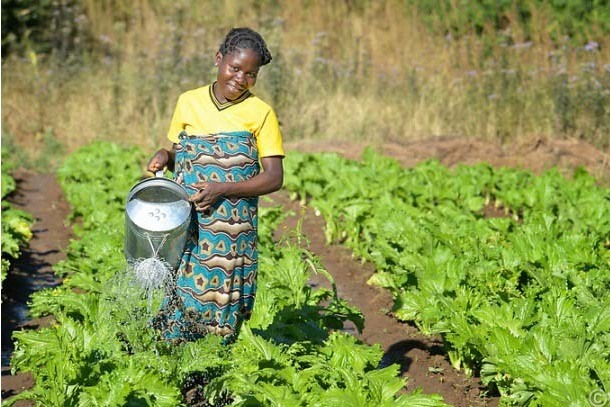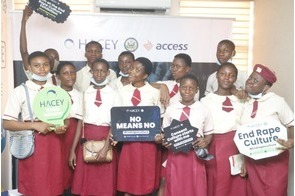Women can play a multipurpose role in ending malnutrition and poverty

Summary
Efforts to end poverty through empowering women and other vulnerable groups will help us achieve the SDG zero-hunger and malnutrition targets.
A wealthy population is able to purchase an assortment of foods, including animal products like meat, fish, egg, and milk, which are rich in protein. Those who have the affordability can also buy fruits and vegetables, which are rich in essential vitamins and minerals.
The reverse is often the case for the poor who usually lack access to the right varieties of food at the right proportions. Many times, all they can afford are energy-rich staple foods, depriving the body of other essential nutrients required for proper growth and development. According to the World Bank, more than half (51.4%) of the extreme poor live in sub-Saharan Africa (SSA). And majority of the global poor are found in rural areas.
The latest United Nations report on the number of undernourished people in the world shows that undernourishment has been on the rise since 2014, reaching an estimated 821 million people in 2017. Unfortunately, 151 million of those affected (or 18.4%) are children under the age of five. Between 2016 and 2017, the number of hungry people in the world – that is, those dealing with chronic food deprivation – increased by 17 million. Food deprivation affects 256 million people in Africa (or 21% of the population). This means Africa has the highest Prevalence of Undernourishment (PoU), although Asia has the highest absolute number of undernourished people in the world, according to the United Nations Food and Agriculture Organisation (FAO).
In West Africa, for example, there has been a very significant increase in PoU between 2014 and 2017. This value is accounted for by over 36 million people in the region. Yet, under the Sustainable Development Goals (SDGs), the world has a target to end all forms of malnutrition by 2030. These include stunting and wasting in children. The SDG target also involves sorting out the nutritional needs of women of reproductive age, pregnant women and nursing mothers and the elderly.
The World Health Organisation (WHO) defines stunting in children as the impairment of growth and development due to inadequate nutrition, reoccurring infection and the combined influence that economic and social factors in the environment have on their physical and mental wellbeing. Children who are too short for their age and are not growing well are said to be stunted; while wasting refers to a condition in which a child is too thin for his or her height. Wasting in children increases their susceptibility to diseases and FAO estimates the prevalence of wasting in Africa to be 7.4% of its population in 2016.
The root cause of household food insecurity is poverty. Poverty and malnutrition have a direct link. Therefore, for us to achieve the goal of zero hunger by 2030, we must first put an end to poverty in Africa. Otherwise, Africa may become chiefly responsible for the inability to actualise the second SDG.
As rightly stated by Prof Jose Graziano da Silver, the Director General of the FAO, “unless economic growth is made more inclusive, the global goals of ending poverty and achieving zero hunger by 2030 will not be reached.” I see the reality of this statement everyday in Ibadan, the city where I live in Nigeria. It is now commonplace to find many able-bodied men and women – alongside their children – begging for alms. This is the case in almost every city in Nigeria as the country has become the poverty capital of the world, having overtaken India as the country with the highest number of people living in extreme poverty.
To be sure, people openly live on the streets of the world’s major urban centres. In fact, it is estimated that as much as 150 million people (or about 2% of the world’s population) are homeless, and up to 1.6 billion (over 20% of global population) lack adequate housing, based on a survey in 2015 by the UN. To bring these figures closer home, the Bureau of Public Service Reforms (BPSR), in 2017, stated that over 108 million Nigerians were technically homeless.
There may not be enough evidence to prove that everyone living on the street is as a result of poverty because there are other reasons for homelessness. Some people are suffering from drug addiction, while others may have been displaced as a result of conflicts or adverse weather conditions like flood. But when you see several “families of beggars,” it narrows down the proximate reason for their homelessness to poverty. Poverty is also the reason these people may not be able to meet the nutritional needs of their members.
Because women play a very crucial role in nutrition, particularly child nutrition, we must work to ensure that poverty eradication programmes are gender sensitive and inclusive. When women and girls are empowered, families tend to be healthier. Empowering women is, in fact, very important because women are often the primary caregivers. The result of such empowerment will be an improvement in the nutritional status of children, who eventually become adults, and the entire household.
Aside this, a more critical reason for empowering women is to reduce the high incidence of anemia in pregnant women in low- and middle-income countries. Anemia – a condition in which a person lacks enough healthy red blood cells to carry adequate oxygen to the body’s tissues – affects 50% of pregnant women in these countries. This happens when the woman’s diet is short of iron and folate-rich foods.
But if pregnant women can afford to eat protein-rich foods – such as meat, fish, eggs and so on – and leafy vegetables and fruits; and if they are also able to purchase multivitamin and mineral pills for additional folate, thousands of lives could be saved.
Moreover, data from UNICEF pegs the number of Low Birth Weight (LBW) in infants at birth in SSA in 2014 at 13%. The good news is that if we empower more women and give them greater opportunities to thrive locally in their countries, the incidence of anemia and maternal mortality, which are often caused by undernourishment and LBW, could be greatly reduced.
If we must end malnutrition by 2030, our efforts to end poverty must begin with empowering women and adolescent girls as well as promoting inclusive economic growth. Inclusive economic growth entails an increase in the equitable distribution of a country’s productive capacity, thereby creating more opportunities for everyone to thrive. The Rockefeller Foundation says that an inclusive economy allows expanded opportunities, especially for those faced with the biggest obstacles to advancing their wellbeing. The aim of inclusive growth is to carry everyone along the growth ladder and broaden shared prosperity.
Therefore, programmes focused on empowering women – particularly those of reproductive age in rural communities – and giving them more opportunities should include facilitating their access to education, agricultural resources, financial services and extension services.
Education in rural areas should be taken more seriously with more government investment in that sector. Many rural households who cannot afford to educate all their children often decide to leave the girls behind while the boys go to school. These girls later become victims of wrong choices and early marriages. They give birth to too many children, thereby adding to the absolute number of the extreme poor in the society.
Giving rural women access to agricultural resources and financial support will draw countries closer to achieving shared prosperity. As a result, the number of women who would leave their rural communities to beg for alms in the streets of urban centres will be greatly reduced.
We also have to promote women’s access to fair labour markets and decent jobs – even for those with the lowest level of education. These efforts to end poverty through supporting and empowering women and other vulnerable groups will help us achieve the SDG zero-hunger and malnutrition targets by 2030.
Financial Nigeria Columnist, Mojisola Karigidi, is a Nigerian biochemist and the founder and product developer at Moepelorse Bio Resources. She is also a Global Innovation Through Science and Technology (GIST) awardee, and an Aspen New Voices fellow.
Related
-
Access Bank wins Women in Marketing and Communications Awards 2020
Access Bank will continue to strive to ensure that women are empowered – Herbert Wigwe.
-
Facebook partners She Leads Africa to support female entrepreneurs
She Leads Africa has built a global community of over 100,000 members across Africa and the diaspora.
-
Access Bank is supporting global campaign to end violence against women
Violence against women poses serious consequences to their health and well-being.










